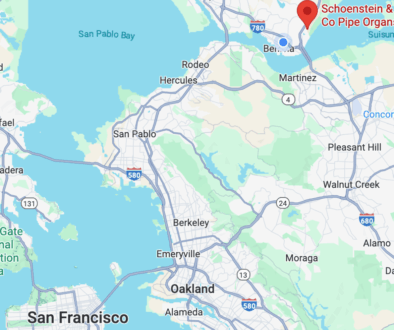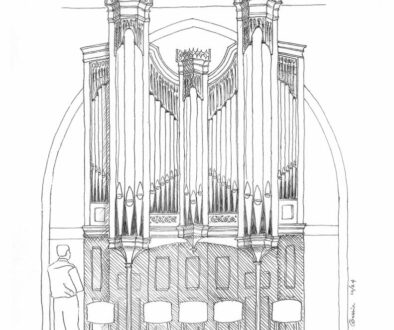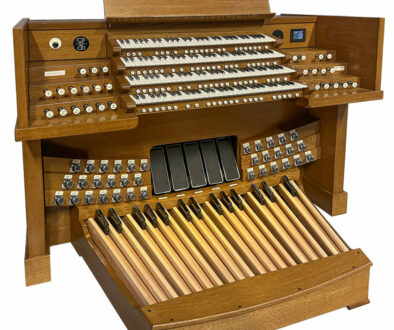A World of Difference from a Single Stop
When organist Douglas Brown approached us to build an organ for Union Presbyterian Seminary of Richmond, VA, he had a singular focus: maximum dynamic and tonal color range fitting within a small organ loft. Over the years our multum in parvo approach has led to versatile instruments in small spaces, and Union Presbyterian Seminary joins a unique group of organs in this style which contain only one double-enclosed stop. (The other two being Bishop Spencer Place, Kansas City, MO; and Wesley Memorial UMC, High Point, NC.)
Watts Chapel, housed in a beautiful, historic Late Victorian building from 1896, is a semi-circular room with the organ placed above and behind the dais. This allows the organ to speak directly into the chapel – a great advantage. After careful measuring, we determined that an organ of 8 ranks would be all that can fit in the tight space. The organ would be entirely enclosed, save a few bass and facade pipes, and only the most essential stops would be chosen. We knew that the double-enclosed Trumpet would be a key part of the organ’s success.
One of the primary advantages of double-expression is the ability to create more dynamic range while retaining the smooth crescendo and decrescendo of a swell box. In larger organs, we double-enclose the softest and loudest stops of the organ to expand both sides of the dynamic spectrum. In smaller organs, we double-enclose only the Trumpet to increase the dynamic range upward. The double-enclosed Trumpet expands organ’s tonal range in several ways: a) the Trumpet stop can be voiced louder and thus play from pp to fff, b) the Trumpet can serve as both a solo and ensemble stop, and c) the rest of the organ’s expression can essentially be controlled separately. Where in the jobs mentioned above we had an 8’ Trumpet double-enclosed, here we were able to add a 16’ octave.
Another advantage to double-expression is its ability to change a stop’s identity. By “setting” the inner swell to the appropriate dynamic level, the organist can use the single Trumpet stop as quieter ensemble stop, apt for choir accompaniment. The organist could also open the inner shades enough for a “standard” swell chorus reed. And if the shades are open all the way the Trumpet can gain enough power to be a solo reed fit for wedding processions and English choral anthems.
When using the Trumpet in these various ways, the overall effect would be severely limited by having the whole organ under the same expression. However, thanks to double-expression, the rest of the organ can be controlled independently of the Trumpet. This allows for more dynamic control while maintaining the Trumpet’s relationship to the rest of the organ. For example, if the Trumpet is being used as a quieter accompaniment stop it can still crescendo and decrescendo in even proportion to the rest of the organ.
Douglas Brown, Director of Music, played the dedicatory service on September 25. From the seamless introductory crescendo in Balfour Gardiner’s Evening Hymn to a heroic performance of Widor’s Toccata from the fifth symphony, Brown has already demonstrated the breadth of color and dynamic available on such a small organ. The organ is now in consistent use for services and events, and we are especially proud to have this organ give musical inspiration and training to future generations of Presbyterian ministers.
Bryan Dunnewald
Schoenstein & Co.


